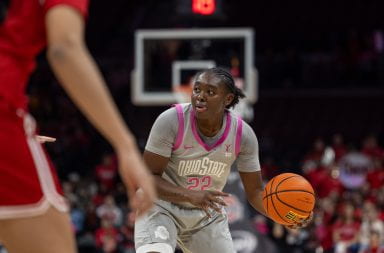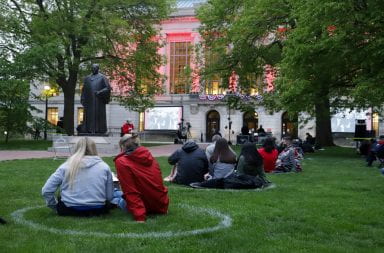Many have dreamt of one day running through the tunnel into Ohio Stadium with cheers of the crowd echoing in the background. Ohio State alumnus Don Handfield, however, envisioned a slightly different experience.
Living the dream of writing and directing a film, “Touchback” sees Handfield’s dreams transformed into reality when he was given the opportunity to shoot scenes in the Horseshoe during the Purdue game in 2010.
Buckeye fans will have the opportunity to see that particular footage when “Touchback” hits theaters Friday. Handfield will be introducing the film Friday at AMC Lennox Town Center 24 with a Q-and-A session following the film. The event is scheduled to begin at 7:20 p.m.
“Touchback” centers around a former high school football star, Scott Murphy, who, 15 years after an injury sidelined him from the game, has an opportunity to relive his glory days on the field. Given a chance to determine his own fate, Murphy uses guidance from influential people in his life, including his football coach, to shape the reality he chooses to face.
This opportunity to select his own path in life – either as a financially drained, disabled farmer or an upcoming football star at OSU – is an element, Handfield said, that separates the storyline from other movies.
“There’s not usually a single moment in time where the character has to make a choice that will affect their life, knowing at the time the values that are put on the line,” Handfield said. “What they have to sacrifice or give up in that choice is something that is fascinating to watch as a human being. I wanted to try to put it on film – the singularity of choice.”
Kurt Russell plays Murphy’s mentor, Coach Hand. The role marks another on-screen coaching experience for Russell. He portrayed coach of the 1980 U.S. hockey team, Herb Brooks, in the 2004 film “Miracle.”
Differentiating Russell’s character from the role he played in “Miracle” was a bit of a challenge, Handfield said, though the “emotional sensitivity” with which Hand was written helped the process.
Inspired by Handfield’s high school wrestling coach, the role was originally written alongside and intended for another well-known actor, Kevin Costner.
“(Costner) was a big part in creating the sensitivity of the character,” Handfield said. “Honestly, I think the work I did with Kevin (Costner) is why Kurt (Russell) responded so strongly to the material. But really (Russell) was instrumental in bringing the character to another level.”
Brian Presley plays the main character, Murphy.
Presley, a former state champion quarterback in high school and walk-on football player at the University of Arkansas, serves as another example of Handfield looking to add genuine footage to the movie.
“Brian is a rare find in the sense that he’s a guy that can really drop back, run a pattern and throw a pass,” Handfield said. “To have a guy like that, who can also act, brings a level of authenticity to (‘Touchback’) that really excited me.”
Set in Coldwater, Ohio, filming for the movie took place in various small towns throughout and surrounding Ohio, including Coopersville, Mich., Coshocton, Ohio, and Warsaw, Ohio.
Although studios originally pushed for the movie to be filmed in California, Handfield’s persistence to maintain authenticity eventually won out.
“Ohio, really the Midwest as a whole, everything about it is different – the sky is different, the siding on the houses is different and the people are different,” Handfield said. “Once the producers got to the Midwest and saw what I meant, they were 100 percent behind it.”
Producers were allowed to film in Ohio Stadium at no charge, said Rick Van Brimmer, OSU director of trademark and licensing services.
“We really don’t charge promotional fees or for the use of the props or location, as long as they’re public spaces,” Van Brimmer said. “Plus, in that case it wasn’t like we had to set things up and open up the stadium just for them. If we do anything special on the campus, certainly they’re responsible for those expenses, but in that particular case, we were having a football game that day so we just had to arrange having them down on the field.”
Although scenes shot inside the Horseshoe will most likely gain the attention of OSU fans, high school football is also well-represented. Footage shown in the film was taken during a game between River View High School and Coshocton High School.
Both schools are in counties with a population fewer than 50,000 people, less than half the capacity of the Horseshoe on gamedays.
Not only a pivotal aspect in regard to the setting of the film, the essence of small-town life also served as a point of inspiration, Handfield said.
“I always thought small towns were romantic,” Handfield said. “I just fell in love with the community and how everyone knows each other. That’s absolutely a very important part of the film.”
Doug Spade, superintendent of River View Local Schools, also considers small town life to be unmatched, especially in regard to football.
“We’re out in the middle of nowhere, so it’s not just a school, it’s also kind of a meeting place,” Spade said. “Friday night lights is the real deal here. It’s not just with one high school, it’s more of a cultural thing. It’s what we do. It isn’t just about the football players – it’s the band, boosters and cheerleaders. It’s about community pride in a lot of different ways.”
Jeff Pejsa, president of Block “O” and a third-year in communication technology, said he looks forward to the possibility of experiencing the atmosphere of gamedays in the ‘Shoe as it is highlighted on the big screen.
“(Watching a game in Ohio Stadium is) a once-in-a-lifetime thing,” Pejsa said. “Even though I get to go see 20 or 30 Ohio State football games in my student career, some people are lucky to go see one. It’s definitely a memory I’ll cherish forever.”
Although football is a focus point of the film’s storyline, it is not the only thing audiences should expect to take away, Handfield said.
“I needed a representation of a dream. I think Ohio State football is a really great representative of that,” Handfield said. “I hope the audience leaves the theatre thinking about their life and appreciating the things in their life they might not have appreciated before.”


